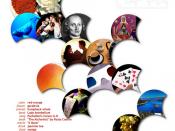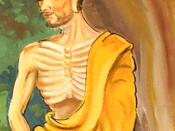Historical Book Review on Siddhartha
Herman Hesse's 'Siddhartha: An Indian Tale' was published in 1922. It is considered to be Hesse's best work and is still very popular to this day. It is a fictitious biography and it records the passage of Siddhartha through phases in life until he attains enlightenment.
To understand why Hesse wrote this book, one most first know some background information about him. Herman Hesse (of German heritage) was, at one point, considered to be a Romanticist author. After World War I, Hesse's perception of life had changed tremendously. His attempts to cope and overcome the troubles and psychological traumas that war can bring is exemplified in his work, his writing turned more to a focus on the self. Hesse walked a new path he called 'Der Wag nach Innen', The Way Within. The Way Within was the road into the interior of the self that perfectly describes Hesse's path, which led to the core of 'Siddhartha'. The type of life that Hesse followed post World War I is of transcending what we percept as reality and finding it within us.
Hesse perceived 'Wirklichkeit' (reality) as an interior dimension. Hesse tries to 'teach' this through the book as Siddhartha can be said to embrace this as he achieves enlightenment at the end of the novel. He chose to not follow the ways of teaching and to experience things for himself, leading the life Buddha is reported to have lead.
As such, this novel is a fictitious biography. It details the life of Siddhartha as he goes through three phases during his life, each lasting roughly 20 years.
The first phase he goes through is the phase of the mind. During this period of his life, Siddhartha is a young, handsome and extremely...



Siddhartha
You have written a good essay on Herman Hesse's widely read book. You are correct when you observe that many consider Siddhartha to be his best book, better even than his popular Steppenwolf. The biographical information which you provide about the author was pertinent because of the many experiences which Hesse incorporated into his text. While I don't agree with much of Hesse's philosophy, there is no denying the appeal of his writing. Your report was analytical and insightful. Good going!
6 out of 6 people found this comment useful.